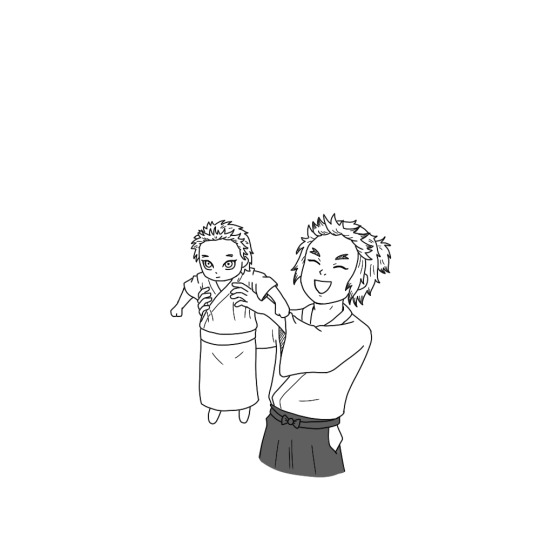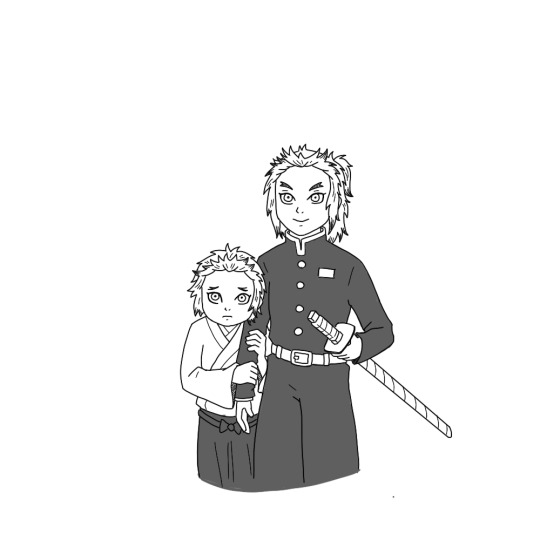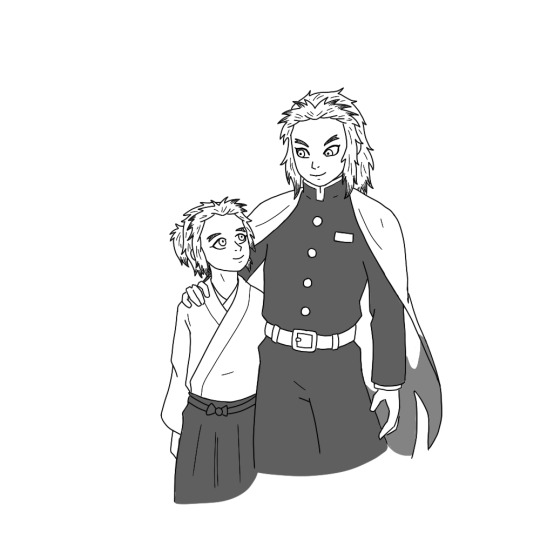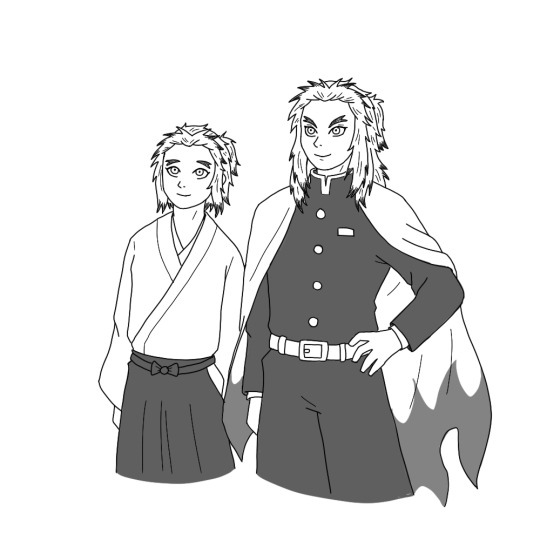Lv. 30 Caffeinated Zombie. KnY| Haikyuu! | BG3 | Stardew Valley | Gacha games
Don't wanna be here? Send us removal request.
Text

Happy birthday my dear Kyojuro 🌻🌻
11 notes
·
View notes
Text

I started doing edits again.
7 notes
·
View notes
Text
Something silly I drew just to learn how to draw these guys. Or, just learn how to draw 😭…







642 notes
·
View notes
Text

Kyojuro Rengoku [Demon Slayer] by TsuyaNoUchi
https://tsuyanouchi.etsy.com
401 notes
·
View notes
Text

some doodles i did
6 notes
·
View notes
Text

The fox and the shrine maiden 🦊
Drew my OC with Rengoku 🫶
13 notes
·
View notes
Text

I wanted to draw these two wearing the clothes shown in the 2025 official art.
23 notes
·
View notes
Text
mfers will say "im against book banning in schools and libraries!" and then turn around and say ao3 needs to be censored
20K notes
·
View notes
Text

I like fox boys a normal amount.
4 notes
·
View notes
Text


art is very tricky,


because it’s what you do for yourself.
1K notes
·
View notes
Text
10 Subtle Ways to Show Love Without Saying “I Love You”
Subtle gestures can convey deep affection and understanding without the need for words. Here are 10 subtle ways to reveal just how much your character cares, without using words:
Surprising Them with Their Favorite Snack
Character A notices Character B eyeing their favorite treat at a store/party, and later surprises them with it, showing they're paying attention to the little things.
Fixing Something Without Being Asked
When Character B's favorite [object] breaks, Character A quietly repairs it and leaves it for them to find.
Leaving a Hidden Note
Character A slips a small note into Character B's bag or coat pocket, something sweet or funny; could be good after a minor fight.
Covering Them with a Blanket
Character B falls asleep on the couch, and Character A drapes a blanket over them gently. Again, cute if it's after a fight.
Warming Their Hands with Theirs
On a chilly day, Character A takes Character B’s cold hands into their own without a word, offering warmth and comfort.
Offering Their Jacket
As Character B shivers in the cold, Character A instinctively hands over their jacket without waiting to be asked. Post-fight cuteness x3
Cleaning Up After a Tough Day
Character B comes home exhausted, and Character A has already tidied up the space. Great if they're married with kids.
Brushing Something Off Their Face
When Character B has a strand of hair or speck of dust on their face, Character A gently brushes it away; a classic, intimate action.
Waiting Up for Them to Get Home
Character A stays up late just to make sure Character B gets home safely, greeting them with a warm smile or a cup of tea when they walk in.
Running an Errand They Dislike
Knowing Character B dreads a particular chore or errand, Character A does it for them without making a big deal, or when they’re stressed/sad.
Looking For More Writing Tips And Tricks?
Check out the rest of Quillology with Haya; a blog dedicated to writing and publishing tips for authors! Instagram Tiktok
5K notes
·
View notes
Text
born to infodump forced to constantly worry if the other person actually cares or if im making sense or if i said something wrong or if im embarrassing myself or if they want me to stop talking or
40K notes
·
View notes
Text
Things Real People Do in Dialogue (For Your Next Story)
Okay, let’s be real—dialogue can make or break a scene. You want your characters to sound natural, like actual humans talking, not robots reading a script. So, how do you write dialogue that feels real without it turning into a mess of awkward pauses and “ums”? Here’s a little cheat sheet of what real people actually do when they talk (and you can totally steal these for your next story):
1. People Interrupt Each Other All the Time In real conversations, nobody waits for the perfect moment to speak. We interrupt, cut each other off, and finish each other's sentences. Throw in some overlaps or interruptions in your dialogue to make it feel more dynamic and less like a rehearsed play.
2. They Don’t Always Say What They Mean Real people are masters of dodging. They’ll say one thing but mean something totally different (hello, passive-aggressive banter). Or they’ll just avoid the question entirely. Let your characters be vague, sarcastic, or just plain evasive sometimes—it makes their conversations feel more layered.
3. People Trail Off... We don’t always finish our sentences. Sometimes we just... stop talking because we assume the other person gets what we’re trying to say. Use that in your dialogue! Let a sentence trail off into nothing. It adds realism and shows the comfort (or awkwardness) between characters.
4. Repeating Words Is Normal In real life, people repeat words when they’re excited, nervous, or trying to make a point. It’s not a sign of bad writing—it’s how we talk. Let your characters get a little repetitive now and then. It adds a rhythm to their speech that feels more genuine.
5. Fillers Are Your Friends People say "um," "uh," "like," "you know," all the time. Not every character needs to sound polished or poetic. Sprinkle in some filler words where it makes sense, especially if the character is nervous or thinking on their feet.
6. Not Everyone Speaks in Complete Sentences Sometimes, people just throw out fragments instead of complete sentences, especially when emotions are high. Short, choppy dialogue can convey tension or excitement. Instead of saying “I really think we need to talk about this,” try “We need to talk. Now.”
7. Body Language Is Part of the Conversation Real people don’t just communicate with words; they use facial expressions, gestures, and body language. When your characters are talking, think about what they’re doing—are they fidgeting? Smiling? Crossing their arms? Those little actions can add a lot of subtext to the dialogue without needing extra words.
8. Awkward Silences Are Golden People don’t talk non-stop. Sometimes, they stop mid-conversation to think, or because things just got weird. Don’t be afraid to add a beat of awkward silence, a long pause, or a meaningful look between characters. It can say more than words.
9. People Talk Over Themselves When They're Nervous When we’re anxious, we tend to talk too fast, go back to rephrase what we just said, or add unnecessary details. If your character’s nervous, let them ramble a bit or correct themselves. It’s a great way to show their internal state through dialogue.
10. Inside Jokes and Shared History Real people have history. Sometimes they reference something that happened off-page, or they share an inside joke only they get. This makes your dialogue feel lived-in and shows that your characters have a life beyond the scene. Throw in a callback to something earlier, or a joke only two characters understand.
11. No One Explains Everything People leave stuff out. We assume the person we’re talking to knows what we’re talking about, so we skip over background details. Instead of having your character explain everything for the reader’s benefit, let some things go unsaid. It’ll feel more natural—and trust your reader to keep up!
12. Characters Have Different Voices Real people don’t all talk the same way. Your characters shouldn’t either! Pay attention to their unique quirks—does one character use slang? Does another speak more formally? Maybe someone’s always cutting people off while another is super polite. Give them different voices and patterns of speech so their dialogue feels authentic to them.
13. People Change the Subject In real life, conversations don’t always stay on track. People get sidetracked, jump to random topics, or avoid certain subjects altogether. If your characters are uncomfortable or trying to dodge a question, let them awkwardly change the subject or ramble to fill the space.
14. Reactions Aren’t Always Immediate People don’t always respond right away. They pause, they think, they hesitate. Sometimes they don’t know what to say, and that delay can speak volumes. Give your characters a moment to process before they respond—it’ll make the conversation feel more natural.
Important note: Please don’t use all of these tips in one dialogue at once.
13K notes
·
View notes




